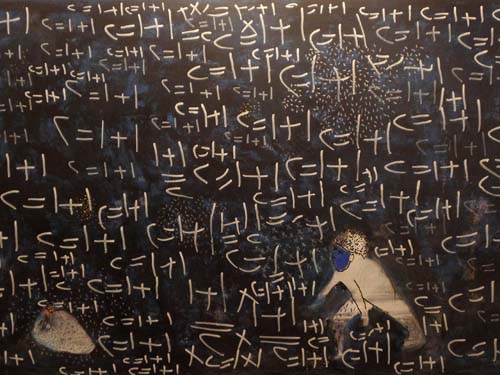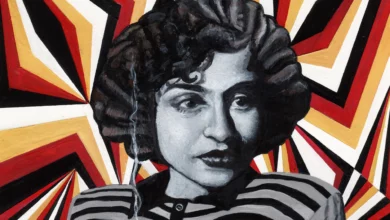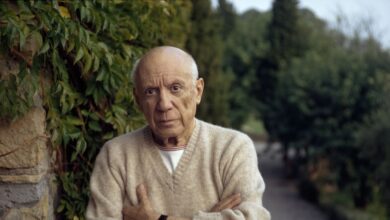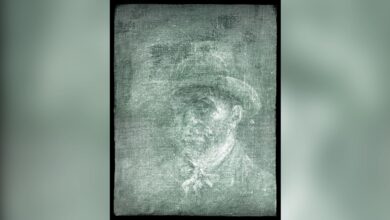
Visual artist Ramy Dozy is featuring his latest collection of work in the exhibit “Alia’s Drinks: Fruit Paradise — Mustache of an Old Man” at the Mashrabia Gallery in downtown Cairo.
In the past, the artist heavily made use of kitsch advertising and aesthetics from around Egypt as a source of inspiration. For example, in his previous solo exhibit “Vanilla Eye Candy,” the Michelin Man logo was pasted onto a canvas below the name “Saad Sosta” (Suspension Saad), simply — and comically — because it was the nickname of a mechanic who lived on his street as a kid.
But in his newer work, Dozy seems to leave the tongue-in-cheek kitsch world behind in order to zone in on even more primitive and childish ideas. Many of the pieces look like fun, abstract cave paintings done by not one, but many children. The playful primacy in Dozy’s latest work brings to mind the work by New York graffiti artist from the 1980s, Jean-Michel Basquiat.
But Dozy’s love of localized kitsch is not completely exhausted just yet. When looked at closely, many of the works still contain random Arabic brand names and logos on the corners — particularly those used by children such as sports logos, chewing gum and tissue paper.
While many of Dozy’s newer pieces have an immediate, childlike appeal, there is also an apparent, new-found love for intricate detail. A lot of the new work is covered in elaborate and repetitive little dots that sometimes look like ants crawling over the artwork, and at other times seem like clusters of stars and galaxies. The difference depends on where one is standing, as well as the overall content of the piece.
One of the most enjoyable pieces in the exhibit is the first to be seen when walking into the gallery. It looks like a primitive cave painting, featuring a white caveman with hundreds of insect-like shapes crawling around on a black background. On top of it all, Dozy has written “1+1=2” in Arabic repeatedly to the point that the images are slightly obscured. The image evokes primitive cave paintings, and while the idea may seem simple, there is a playfulness and honesty in its execution — like with most of Dozy’s work — that makes generally banal concepts and sketches naturally come to life.
About two months ago, I visited Dozy at his home, which is essentially the bare roof of a Zamalek building. At the time, he would spend hours watching armies of ants (and other insects) attack and take bits of food apart while copying the patterns of the ants onto paper. There were hundreds of these types of works all over the rooftop. Dozy would also record hours of close-up, detailed footage of similar things and watch it obsessively on his computer later. I had no idea about his latest exhibit at the time, but it seems Dozy had the perfect place in mind for his hours upon hours of tedious, repetitive work.
As an artist, Dozy is tireless. And like Basquiat, images that seem like the work of a five-year-old are actually the result of hours of contemplation, dedication and effort. That being said, the contemplation and effort is not pedantic in the slightest, but simply part of Dozy’s carefree, stream-of-conscious style. These traits are translated very well in his latest exhibition.
The result is, as always, very beautiful, honest and clever. However, after circling the gallery several times, I was still unable to understand why the title “Alia’s Drinks: Fruit Paradise — Mustache of an Old Man.”
When asked, Dozy explains that when he lived in the Ard al-Lewa neighborhood in Giza, he once saw a small girl (Alia) hit hard by an older man. After being struck, she gave him a penetrating stare. Shocked by her gaze, the man walked away quickly.
“It was powerful,” says Dozy. “That energy really struck me, and I instantly became inspired to get out of the house more and explore Ard al-Lewa, while also watching Alia play.” Dozy says that while creating his latest work, Alia kept coming to mind, so he attributed the work to her.
But why drinks?
The final title seems the perfect example of Dozy’s artistic sensibility at work.
“While in Ard al-Lewa, with Alia playing in the background, I would often visit coffee shops and juice stands,” he explains. “I soon noticed that all the juice stands were called ‘Ganat al-Fawakeh’ (Fruit Paradise), which is first of all ridiculous. But also most of the owners would have huge mustaches. Whenever I would finish one of my juices, I would always find a massive mustache in my face, so I dedicated those drinks and mustaches to Alia.”
“Alia’s Drinks: Fruit Paradise – Moustache of an Old Man” is on display until 14 February at Mashrabia Gallery, 8 Champollion St., downtown, Cairo. Telephone: 010-0170-4554





